
Concept explainers
Draw the products formed when D-altrose is treated with each reagent.
a.
b.
c.
d.
e. [1]
f. [1]
g.
h.
(a)
Interpretation: The products formed by the treatment of D-altrose with
Concept introduction: The
Answer to Problem 28.50P
The products formed by the treatment of D-altrose with
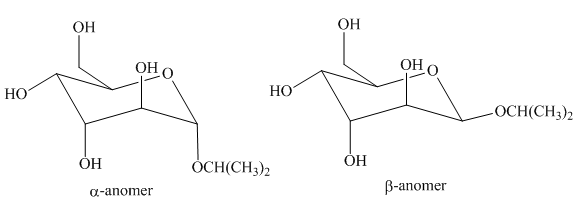
Figure 1
Explanation of Solution
The
The products formed by the treatment of D- altrose with

Figure 2
The products formed by the treatment of D-altrose with
(b)
Interpretation: The products formed by the treatment of D-altrose with
Concept introduction: The substitution reaction involves the replacement of one functional group by other functional group. In nucleophilic substitution an electron rich species attack the species that is deficient in electrons. The electrophile and the leaving group together form a substrate. The nucleophile attacks over the substrate and there occurs the removal of leaving group from the substrate.
Answer to Problem 28.50P
The product formed by the treatment of D-altrose with
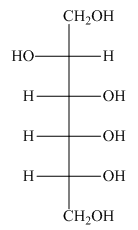
Figure 3
Explanation of Solution
The product formed by the treatment of D-altrose with
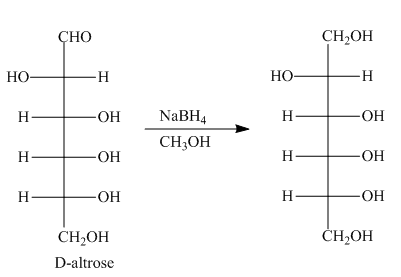
Figure 4
In the given reaction, sodium borohydride is used as a reducing agent. Sodium borohydride is used to for the reduction of carbonyl compounds to alcohols.
The product formed by the treatment of D-altrose with
(c)
Interpretation: The products formed by the treatment of D-altrose with
Concept introduction: The aldehyde group of aldoses oxidizes to carboxyl group on treatment with
Answer to Problem 28.50P
The product formed by the treatment of D-altrose with
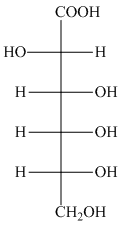
Figure 5
Explanation of Solution
The oxidation of aldehyde group of aldoses leads to the formation of aldonic acid, in which the terminal carbon atoms are substituted by carboxyl group and alcoholic group. The product formed by the treatment of D-altrose with
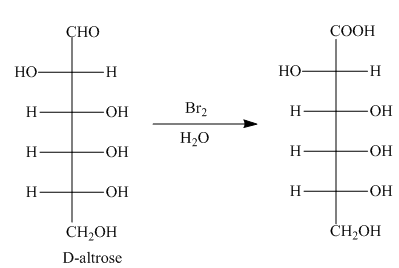
Figure 6
The product formed by the treatment of D-altrose with
(d)
Interpretation: The products formed by the treatment of D-altrose with
Concept introduction: The aldehyde group and primary alcohol of aldoses oxidizes to carboxyl groups on treatment with warm
Answer to Problem 28.50P
The product formed by the treatment of D-altrose with
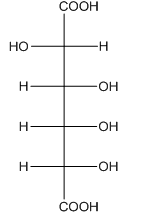
Figure 7
Explanation of Solution
The oxidation of aldehyde group and primary alcohol of aldoses leads to the formation of aldaric acid, in which the terminal carbon atoms are substituted by carboxyl groups. The product formed by the treatment of D-altrose with
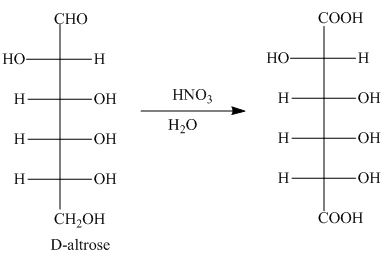
Figure 8
The product formed by the treatment of D-altrose with
(e)
Interpretation: The products formed by the treatment of D-altrose with [1]
Concept introduction:
Answer to Problem 28.50P
The product formed by the treatment of D-altrose with [1]

Figure 9
Explanation of Solution
The reaction of D-altrose with hydroxylamine results in the formation of oxime. The second step is the dehydration of oxime to nitriles. The reaction of nitrile with
The product formed by the treatment of D-altrose with [1]

Figure 10
The product formed by the treatment of D-altrose with [1]
(f)
Interpretation: The products formed by the treatment of D-altrose with [1]
Concept introduction:
Answer to Problem 28.50P
The products formed by the treatment of D-altrose with [1]

Figure 11
Explanation of Solution
The products formed by the treatment of D-altrose with [1]

Figure 12
The products formed by the treatment of D-altrose with [1]
(g)
Interpretation: The products formed by the treatment of D-altrose with
Concept introduction: The
Answer to Problem 28.50P
The products formed by the treatment of D-altrose with
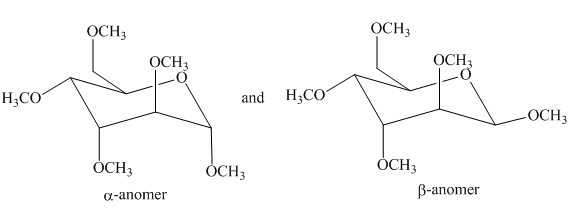
Figure 13
Explanation of Solution
The

Figure 14
The products formed by the treatment of D-altrose with
(h)
Interpretation: The products formed by the treatment of D-altrose with
Concept introduction: The
Answer to Problem 28.50P
The products formed by the treatment of D-altrose with

Figure 15
Explanation of Solution
The

Figure 16
The products formed by the treatment of D-altrose with
Want to see more full solutions like this?
Chapter 28 Solutions
PKG ORGANIC CHEMISTRY
- hybridization of nitrogen of complex moleculesarrow_forwardUsing reaction free energy to predict equilibrium composition Consider the following equilibrium: 2NO2 (g) = N2O4(g) AGº = -5.4 kJ Now suppose a reaction vessel is filled with 4.53 atm of dinitrogen tetroxide (N2O4) at 279. °C. Answer the following questions about this system: Under these conditions, will the pressure of N2O4 tend to rise or fall? Is it possible to reverse this tendency by adding NO2? In other words, if you said the pressure of N2O4 will tend to rise, can that be changed to a tendency to fall by adding NO2? Similarly, if you said the pressure of N2O4 will tend to fall, can that be changed to a tendency to '2' rise by adding NO2? If you said the tendency can be reversed in the second question, calculate the minimum pressure of NO 2 needed to reverse it. Round your answer to 2 significant digits. 00 rise ☐ x10 fall yes no ☐ atm G Ar 1arrow_forwardWhy do we analyse salt?arrow_forward
- Curved arrows are used to illustrate the flow of electrons. Using the provided starting and product structures, draw the curved electron-pushing arrows for the following reaction or mechanistic step(s). Be sure to account for all bond-breaking and bond-making steps. H H CH3OH, H+ H Select to Add Arrows H° 0:0 'H + Q HH ■ Select to Add Arrows CH3OH, H* H. H CH3OH, H+ HH ■ Select to Add Arrows i Please select a drawing or reagent from the question areaarrow_forwardWhat are examples of analytical methods that can be used to analyse salt in tomato sauce?arrow_forwardA common alkene starting material is shown below. Predict the major product for each reaction. Use a dash or wedge bond to indicate the relative stereochemistry of substituents on asymmetric centers, where applicable. Ignore any inorganic byproducts H Šali OH H OH Select to Edit Select to Draw 1. BH3-THF 1. Hg(OAc)2, H2O =U= 2. H2O2, NaOH 2. NaBH4, NaOH + Please select a drawing or reagent from the question areaarrow_forward
- What is the MOHR titration & AOAC method? What is it and how does it work? How can it be used to quantify salt in a sample?arrow_forwardPredict the major products of this reaction. Cl₂ hv ? Draw only the major product or products in the drawing area below. If there's more than one major product, you can draw them in any arrangement you like. Be sure you use wedge and dash bonds if necessary, for example to distinguish between major products with different stereochemistry. If there will be no products because there will be no significant reaction, just check the box under the drawing area and leave it blank. Note for advanced students: you can ignore any products of repeated addition. Explanation Check Click and drag to start drawing a structure. 80 10 m 2025 McGraw Hill LLC. All Rights Reserved. Terms of Use | Privacy Center | Accessibility DII A F1 F2 F3 F4 F5 F6 F7 F8 EO F11arrow_forwardGiven a system with an anodic overpotential, the variation of η as a function of current density- at low fields is linear.- at higher fields, it follows Tafel's law.Calculate the range of current densities for which the overpotential has the same value when calculated for both cases (the maximum relative difference will be 5%, compared to the behavior for higher fields).arrow_forward
- Using reaction free energy to predict equilibrium composition Consider the following equilibrium: N2 (g) + 3H2 (g) = 2NH3 (g) AGº = -34. KJ Now suppose a reaction vessel is filled with 8.06 atm of nitrogen (N2) and 2.58 atm of ammonia (NH3) at 106. °C. Answer the following questions about this system: rise Under these conditions, will the pressure of N2 tend to rise or fall? ☐ x10 fall Is it possible to reverse this tendency by adding H₂? In other words, if you said the pressure of N2 will tend to rise, can that be changed to a tendency to fall by adding H2? Similarly, if you said the pressure of N will tend to fall, can that be changed to a tendency to rise by adding H₂? If you said the tendency can be reversed in the second question, calculate the minimum pressure of H₂ needed to reverse it. Round your answer to 2 significant digits. yes no ☐ atm Х ด ? olo 18 Ararrow_forwardFour liters of an aqueous solution containing 6.98 mg of acetic acid were prepared. At 25°C, the measured conductivity was 5.89x10-3 mS cm-1. Calculate the degree of dissociation of the acid and its ionization constant.Molecular weights: O (15.999), C (12.011), H (1.008).Limiting molar ionic conductivities (λ+0 and λ-0) of Ac-(aq) and H+(aq): 40.9 and 349.8 S cm-2 mol-1.arrow_forwardDetermine the change in Gibbs energy, entropy, and enthalpy at 25°C for the battery from which the data in the table were obtained.T (°C) 15 20 25 30 35Eo (mV) 227.13 224.38 221.87 219.37 216.59Data: n = 1, F = 96485 C mol–1arrow_forward
 Introductory Chemistry: A FoundationChemistryISBN:9781337399425Author:Steven S. Zumdahl, Donald J. DeCostePublisher:Cengage Learning
Introductory Chemistry: A FoundationChemistryISBN:9781337399425Author:Steven S. Zumdahl, Donald J. DeCostePublisher:Cengage Learning
